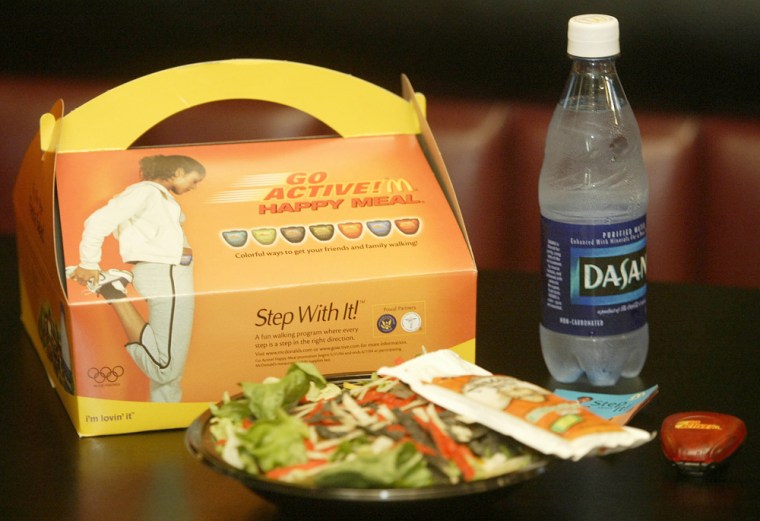Chicken, salads, soup and breakfast.
From the way McDonald's is touting its lineup of healthful items and other nontraditional menu choices, you would think it doesn't even sell hamburgers any more.
The company went out of its way to cite the "strong" performance of its white-meat chicken items, along with better-than-expected overseas results, in announcing a 5 percent same-store sales jump in December from a year ago. That performance led to an upgraded prediction in fourth-quarter earnings of 48 cents per share, a penny above Wall Street estimates.
Ralph Alvarez, president of McDonald's North America, says there's more new fare to come. Speaking to the National Retail Federation convention in New York on Monday, Alvarez said 2006 will bring more "freshly prepared foods," to the fast-food king's menu, including more spicy chicken items and high-end coffee. That's on top of the salads, white-meat chicken and low-fat milk that the company has largely credited for a turnaround from its first-ever quarterly loss over three years ago.
"Customers want more choices in a more contemporary environment," Alvarez told the conference.
McDonald's stock price has roughly tripled since sinking to $12.38 per share on March 12, 2003, the day the market began its comeback from a two-year slump. Year-over-year sales have grown for 32 straight months. That's been enough for Chief Executive James Skinner, who's been on the job for 14 months, to favor a back-to-basics approach centered around pleasing the customer. Along with the company's board of directors, he's rejected a plan pushed by private equity firm Pershing Square Capital to sell off some company-owned restaurants and distribute the proceeds to stockholders through dividends and share buybacks. The latest twist in the proposal from Pershing founder William Ackman calls for the formation of a new company — 20 percent of which would be sold off in a public offering — to take control of 1,000 of those restaurants located in mature markets and sell them to the public.
Meanwhile, even though many McDonald's menu boards now suggest that customers have the option to "add Campbell's soup to any meal," it's hard to find many of them slurping chicken broth. People — especially Americans — still love a hamburger. And they're coming to Mickey D's in stronger numbers recently, drawn to refurbished restaurants and to improved service that have put the "fast" back into fast food.
"The No. 1 entree ordered by men in America is a hamburger," says Henry Balzer, a vice president with NPD Foodworld who tracks data on eating habits. "And the No. 1 entree among women is a french fry, followed by a hamburger." NPD Group surveys show that the prevailing wisdom that people are more health conscious today than in past years is mostly myth. The number of people concerned about the amount of fat they consume has actually declined over the years — to 30 percent today from over 50 percent in 1994 — the group's latest survey showed.
As for the company's plans to introduce high-end coffee? Balzer says that while java can throw off a steady cash stream, it's not a growth segment. "Americans drink less coffee than they did ten and 20 years ago," he says.
While McDonald's does not officially break down sales by menu item, "the 80-20 rule is going strong," says industry consultant Jerry McVety of McVety & Associates, meaning that 80 percent of the company's revenue can be attributed to 20 percent of its products, led by its flagship burgers and fries.
Certainly, soups and salads have added incremental revenue, since they serve that segment that has made a commitment to healthier eating. They also make for effective window dressing, helping to keep critics and regulators quiet. The breakfast menu, meanwhile, aids profit margins by letting the company allocate overhead costs across more revenue and operating hours. But a fast-food fixture that has measured its success in terms of "billions served" can't live on lightweight salads that people can get anywhere. It must beef up sales of Big Macs and Quarter Pounders. Given the 80-20 rule, a 5 percent drop in burger and fries sales, coupled with a 10 percent gain in "new menu" items would net out to a 2 percent drop in revenue. For a $20 billion company like McDonald's, that's a $400 million hit.
McDonald's burger battle plan against the likes of privately held Burger King, Wendy's International and Yum! Brands' A&W franchise includes a new hip-hop ad campaign, aimed at making the 35-year-old Big Mac cool to young urbanites. The company has also won high marks for its new Arch Card payment system, effectively a store credit card. About half of its 10,000 North American locations are being rebuilt or refurbished to yield more wood, metal and artwork, and fewer plastic seats. Service and quality-control initiatives include more English-Spanish training for store workers, mystery shoppers assigned to put pleasant service to the test, and an "e-learning" program to update employees on new products and services more quickly.
And the crowd-drawing dollar menu is apparently here to stay. "Part of our mission is to keep prices below the 'food away from home' inflation rate," Alvarez told the NRF conference, speaking of that particular component of the monthly consumer price index.
Alvarez said the company learned about enhancing the customer experience from surveying other retailers like Starbucks and Crate & Barrel, each of which generally wins high marks for its inviting atmosphere.
"Retail lines have blurred," Alvarez said. "You need to be big, but you can't be slow."
